Effects of Phase Evolution on Mechanical Properties of Laser-Welded Ferritic Fe-Al-Mn-C Steel
Abstract
:1. Introduction
2. Experimental Procedure
3. Results and Discussion
3.1. Tensile Properties of Laser Welds
3.2. Confirmation of Segregation of Carbides and Secondary Phase at Failure Surface
3.3. Effect of Microstructure and Its Incompatibility on Fracture Behavior
3.4. Effect of Heat Input on Mechanical Properties
4. Conclusions
- (1)
- Typical brittle fracture surfaces were observed. Further, while cleavage was seen, dimples were not. The experimental results indicated that carbide or secondary phase particles were not present on the failure surface. The phases formed were also determined through simulations performed using commercial thermodynamic software. The simulation results were in good agreement with those obtained experimentally.
- (2)
- The HAZ and FZ were composed of ferrite, austenite, and martensite phases. Thus, contact ferrite/martensite and austenite/martensite interfaces with a high degree of incompatibility were formed. Incompatibility between the phases can induce voids even in the case of small deformations. These defects subsequently connect to each other and propagate to form a crack. Thus, incompatibility between the phases was the primary reason that failure occurred in the HAZ.
Acknowledgments
Author Contributions
Conflicts of Interest
References
- Bouquerel, J.; Verbeken, K.; De Cooman, B. Microstructure-based model for the static mechanical behaviour of multiphase steels. Acta Mater. 2006, 54, 1443–1456. [Google Scholar] [CrossRef]
- Lim, N.; Park, H.; Kim, S.; Park, C. Effects of aluminum on the microstructure and phase transformation of TRIP steels. Met. Mater. Int. 2012, 18, 647–654. [Google Scholar] [CrossRef]
- Bouaziz, O.; Allain, S.; Scott, C.; Cugy, P.; Barbier, D. High manganese austenitic twinning induced plasticity steels: A review of the microstructure properties relationships. Curr. Opin. Solid State Mater. Sci. 2011, 15, 141–168. [Google Scholar] [CrossRef]
- Vercammen, S.; Blanpain, B.; De Cooman, B.; Wollants, P. Cold rolling behaviour of an austenitic Fe–30Mn–3Al–3Si TWIP-steel: The importance of deformation twinning. Acta Mater. 2004, 52, 2005–2012. [Google Scholar] [CrossRef]
- Kim, H.; Suh, D.-W.; Kim, N.J. Fe–Al–Mn–C lightweight structural alloys: A review on the microstructures and mechanical properties. Sci. Technol. Adv. Mater. 2013, 14, 014205. [Google Scholar] [CrossRef] [PubMed]
- Suh, D.-W.; Kim, N.J. Low-density steels. Scr. Mater. 2013, 68, 337–338. [Google Scholar] [CrossRef]
- Lee, H.-J.; Sohn, S.S.; Lee, S.; Kwak, J.-H.; Lee, B.-J. Thermodynamic analysis of the effect of C, Mn and Al on microstructural evolution of lightweight steels. Scr. Mater. 2013, 68, 339–342. [Google Scholar] [CrossRef]
- Mujica, L.; Weber, S.; Pinto, H.; Thomy, C.; Vollertsen, F. Microstructure and mechanical properties of laser-welded joints of TWIP and TRIP steels. Mater. Sci. Eng. A 2010, 527, 2071–2078. [Google Scholar] [CrossRef]
- Seo, C.-H.; Kwon, K.H.; Choi, K.; Kim, K.-H.; Kwak, J.H.; Lee, S.; Kim, N.J. Deformation behavior of ferrite-austenite duplex lightweight Fe–Mn–Al–C steel. Scr. Mater. 2015, 66, 519–522. [Google Scholar] [CrossRef]
- Sohn, S.S.; Lee, B.-J.; Lee, S.; Kim, N.J.; Kwak, J.H. Effect of annealing temperature on microstructural modification and tensile properties in 0.35C–3.5Mn–5.8Al lightweight steel. Acta Mater. 2013, 61, 5050–5066. [Google Scholar] [CrossRef]
- Rana, R.; Liu, C.; Ray, R. Evolution of microstructure and mechanical properties during thermomechanical processing of a low-density multiphase steel for automotive application. Acta Mater. 2014, 75, 227–245. [Google Scholar] [CrossRef]
- Zuazo, I.; Hallstedt, B.; Lindahl, B.; Selleby, M.; Soler, M.; Etienne, A.; Perlade, A.; Hasenpouth, D.; Massardier-Jourdan, V.; Cazottes, S. Low-density steels: Complex metallurgy for automotive applications. JOM 2014, 66, 1747–1758. [Google Scholar] [CrossRef]
- Seol, J.B.; Raabe, D.; Choi, P.; Park, H.-S.; Kwak, J.-H.; Park, C.G. Direct evidence for the formation of ordered carbides in a ferrite-based low-density Fe–Mn–Al–C alloy studied by transmission electron microscopy and atom probe tomography. Scr. Mater. 2013, 68, 348–353. [Google Scholar] [CrossRef]
- Moon, J.; Park, S.-J.; Jang, J.H.; Lee, T.-H.; Lee, C.-H.; Hong, H.-U.; Suh, D.-W.; Kim, S.H.; Han, H.N.; Lee, B.H. Atomistic investigations of κ-carbide precipitation in austenitic Fe–Mn–Al–C lightweight steels and the effect of Mo addition. Scr. Mater. 2017, 127, 97–101. [Google Scholar] [CrossRef]
- Park, S.-J.; Heo, Y.-U.; Choi, Y.H.; Lee, K.; Han, H.N.; Suh, D.-W. Effect of second phase on the deformation and fracture behavior of multiphase low-density steels. JOM 2014, 66, 1837–1844. [Google Scholar] [CrossRef]
- Choi, K.; Seo, C.-H.; Lee, H.; Kim, S.; Kwak, J.H.; Chin, K.G.; Park, K.-T.; Kim, N.J. Effect of aging on the microstructure and deformation behavior of austenite base lightweight Fe–28Mn–9Al–0.8C steel. Scr. Mater. 2010, 63, 1028–1031. [Google Scholar] [CrossRef]
- Frommeyer, G.; Brüx, U. Microstructures and mechanical properties of high-strength Fe–Mn–Al–C light-weight triplex steels. Steel Res. Int. 2006, 77, 627–633. [Google Scholar] [CrossRef]
- Lu, W.; Zhang, X.; Qin, R. Κ-carbide hardening in a low-density high-Al high-Mn multiphase steel. Mater. Lett. 2015, 138, 96–99. [Google Scholar] [CrossRef]
- Sutou, Y.; Kamiya, N.; Umino, R.; Ohnuma, I.; Ishida, K. High-strength Fe–20Mn–Al–C-based alloys with low density. ISIJ Int. 2010, 50, 893–899. [Google Scholar] [CrossRef]
- Han, S.Y.; Shin, S.Y.; Lee, S.; Kim, N.J.; Kwak, J.-H.; Chin, K.-G. Effect of carbon content on cracking phenomenon occurring during cold rolling of three light-weight steel plates. Metall. Mater. Trans. A 2011, 42, 138–146. [Google Scholar] [CrossRef]
- Lee, S.; Jeong, J.; Lee, Y.-K. Precipitation and dissolution behavior of κ-carbide during continuous heating in Fe–9.3Mn–5.6Al–0.16C lightweight steel. J. Alloys Compd. 2015, 648, 149–153. [Google Scholar] [CrossRef]
- Shin, S.Y.; Lee, H.; Han, S.Y.; Seo, C.-H.; Choi, K.; Lee, S.; Kim, N.J.; Kwak, J.-H.; Chin, K.-G. Correlation of microstructure and cracking phenomenon occurring during hot rolling of lightweight steel plates. Metall. Mater. Trans. A 2009, 41, 138–148. [Google Scholar] [CrossRef]
- Gutierrez-Urrutia, I.; Raabe, D. Multistage strain hardening through dislocation substructure and twinning in a high strength and ductile weight-reduced Fe–Mn–Al–C steel. Acta Mater. 2012, 60, 5791–5802. [Google Scholar] [CrossRef]
- Park, K.-T. Tensile deformation of low-density Fe–Mn–Al–C austenitic steels at ambient temperature. Scr. Mater. 2013, 68, 375–379. [Google Scholar] [CrossRef]
- Han, H.N.; Lee, C.G.; Suh, D.-W.; Kim, S.-J. A microstructure-based analysis for transformation induced plasticity and mechanically induced martensitic transformation. Mater. Sci. Eng. A 2008, 485, 224–233. [Google Scholar] [CrossRef]
- Choi, J.Y.; Lee, J.; Lee, K.; Koh, J.-Y.; Cho, J.-H.; Han, H.N.; Park, K.-T. Effects of the strain rate on the tensile properties of a trip-aided duplex stainless steel. Mater. Sci. Eng. A 2016, 666, 280–287. [Google Scholar] [CrossRef]
- Ryu, J.H.; Kim, D.-I.; Kim, H.S.; Bhadeshia, H.; Suh, D.-W. Strain partitioning and mechanical stability of retained austenite. Scr. Mater. 2010, 63, 297–299. [Google Scholar] [CrossRef]
- Doong, J.-L.; Wu, C.-S.; Hwang, J.-R. Infrared temperature sensing of laser welding. Int. J. Mach. Tools Manuf. 1991, 31, 607–616. [Google Scholar] [CrossRef]
- Jung, G.S.; Lee, K.Y.; Bhadeshia, H.K.D.H.; Suh, D.-W. Spot weldability of TRIP assisted steels with high carbon and aluminium contents. Sci. Technol. Weld. Join. 2012, 17, 92–98. [Google Scholar] [CrossRef]
- Choi, Y.J.; Suh, D.W.; Bhadeshia, H.K.D.H. Retention of δ-ferrite in aluminium-alloyed TRIP-assisted steels. Proc. R. Soc. A Math. Phys. Eng. Sci. 2012, 468, 2904–2914. [Google Scholar] [CrossRef]
- Park, H.-S.; Seol, J.-B.; Lim, N.-S.; Kim, S.-I.; Park, C.-G. Study of the decomposition behavior of retained austenite and the partitioning of alloying elements during tempering in cmnsial trip steels. Mater. Des. 2015, 82, 173–180. [Google Scholar] [CrossRef]
- Suh, D.W.; Ryu, J.H.; Joo, M.S.; Yang, H.S.; Lee, K.; Bhadeshia, H.K.D.H. Medium-alloy manganese-rich transformation-induced plasticity steels. Metall. Mater. Trans. A 2012, 44, 286–293. [Google Scholar] [CrossRef]
- Gulliver, G. The quantitative effect of rapid cooling upon the constitution of binary alloys. J. Jpn. Inst. Met. Mater. 1913, 9, 120–157. [Google Scholar]
- Scheil, E. Remarks on stratification. J. Metall. 1942, 34, 70–72. [Google Scholar]
- Han, T.-K.; Park, B.-G.; Kang, C.-Y. Hardening characteristics of CO2 laser welds in advanced high strength steel. Met. Mater. Int. 2012, 18, 473–479. [Google Scholar] [CrossRef]
- Xia, M.; Biro, E.; Tian, Z.; Zhou, Y.N. Effects of heat input and martensite on HAZ softening in laser welding of dual phase steels. ISIJ Int. 2008, 48, 809–814. [Google Scholar] [CrossRef]
- Song, Y.; Hua, L.; Chu, D.; Lan, J. Characterization of the inhomogeneous constitutive properties of laser welding beams by the micro-Vickers hardness test and the rule of mixture. Mater. Des. 2012, 37, 19–27. [Google Scholar] [CrossRef]
- Ion, J.; Easterling, K.E.; Ashby, M. A second report on diagrams of microstructure and hardness for heat-affected zones in welds. Acta Metall. 1984, 32, 1949–1955, 1957–1962. [Google Scholar] [CrossRef]
- Bang, K.; Kim, W. Estimation and prediction of HAZ softening in thermomechanically controlled-rolled and accelerated-cooled steel. Weld. J. 2002, 81, 174S–179S. [Google Scholar]
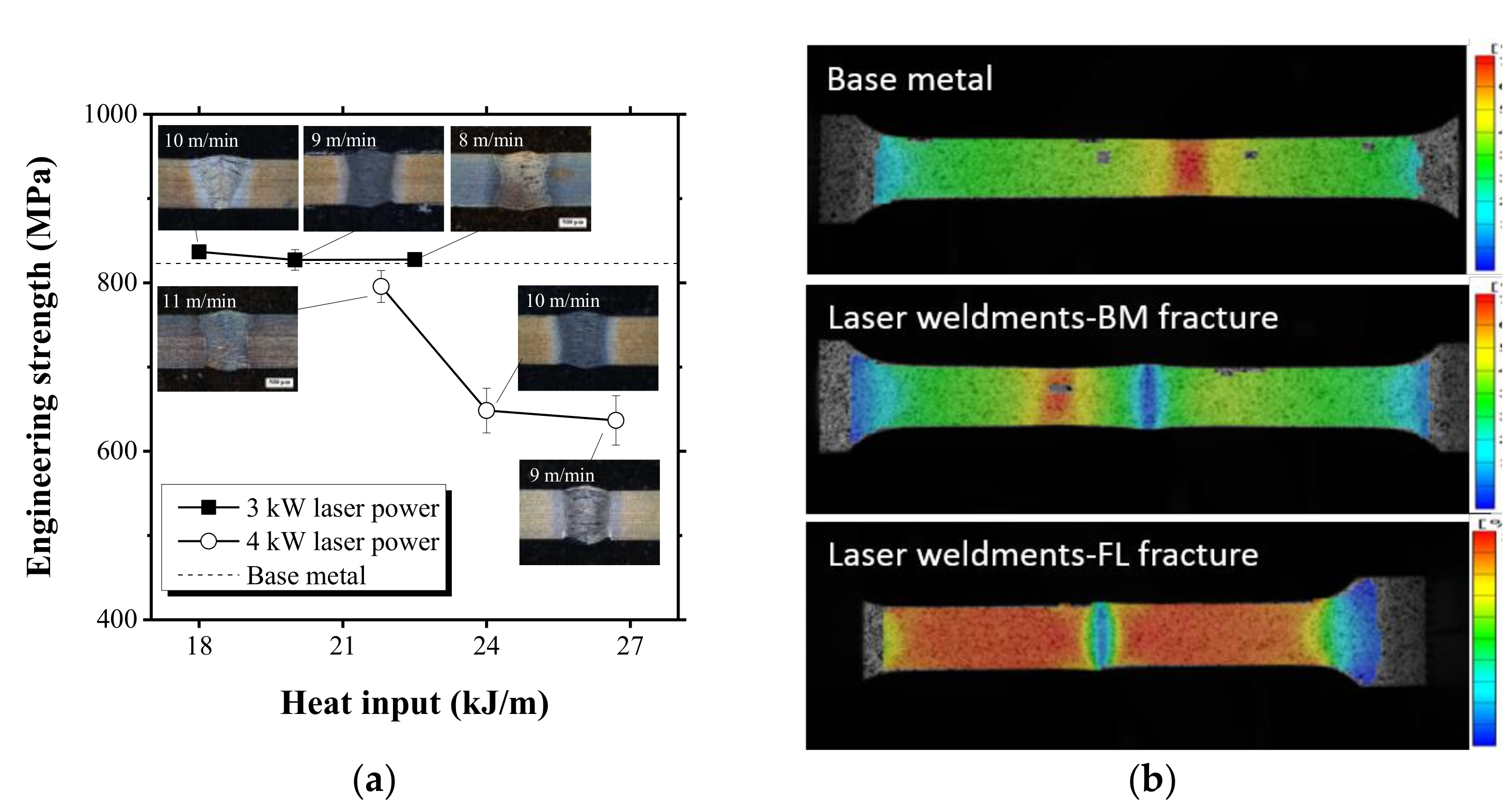
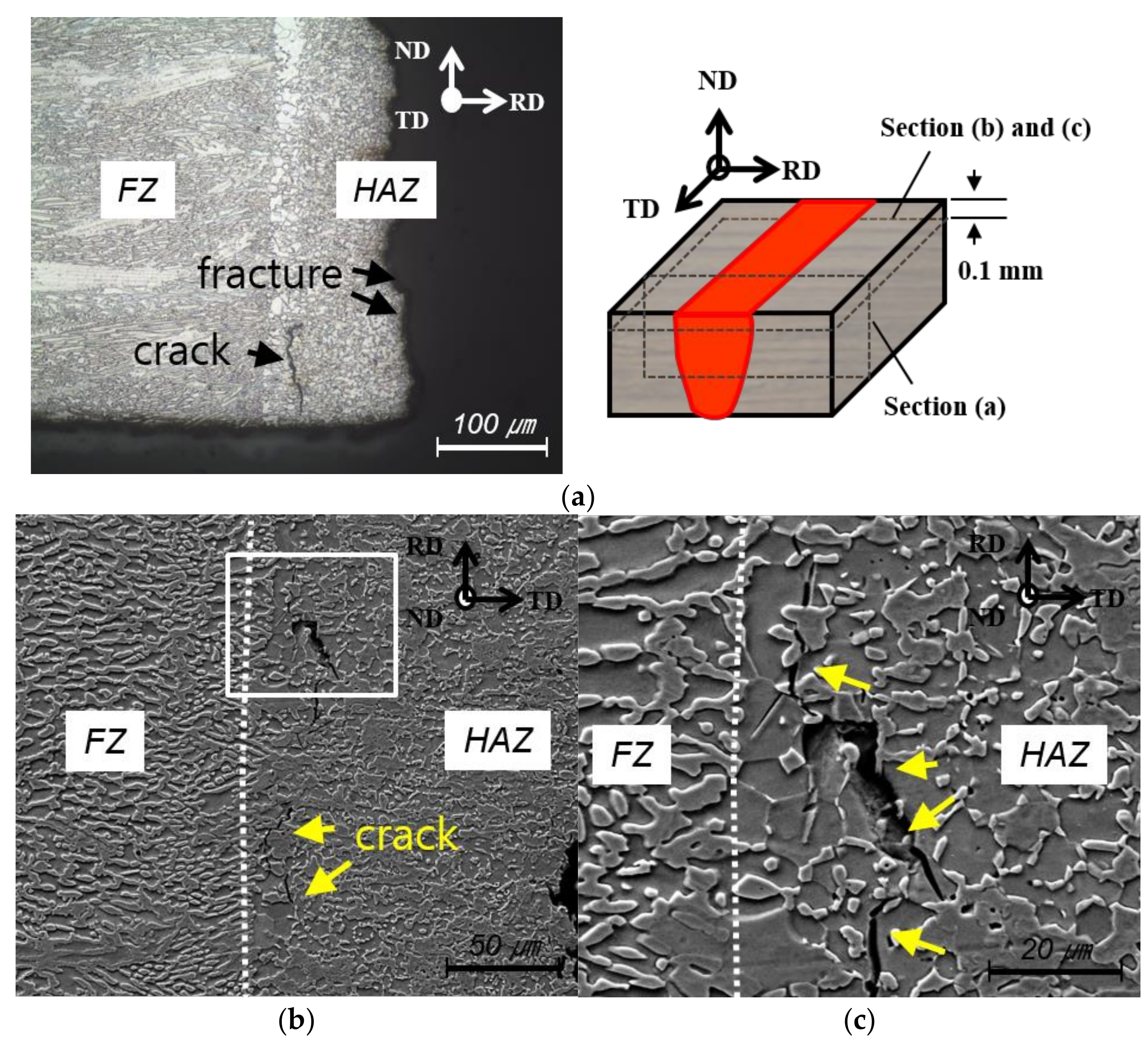
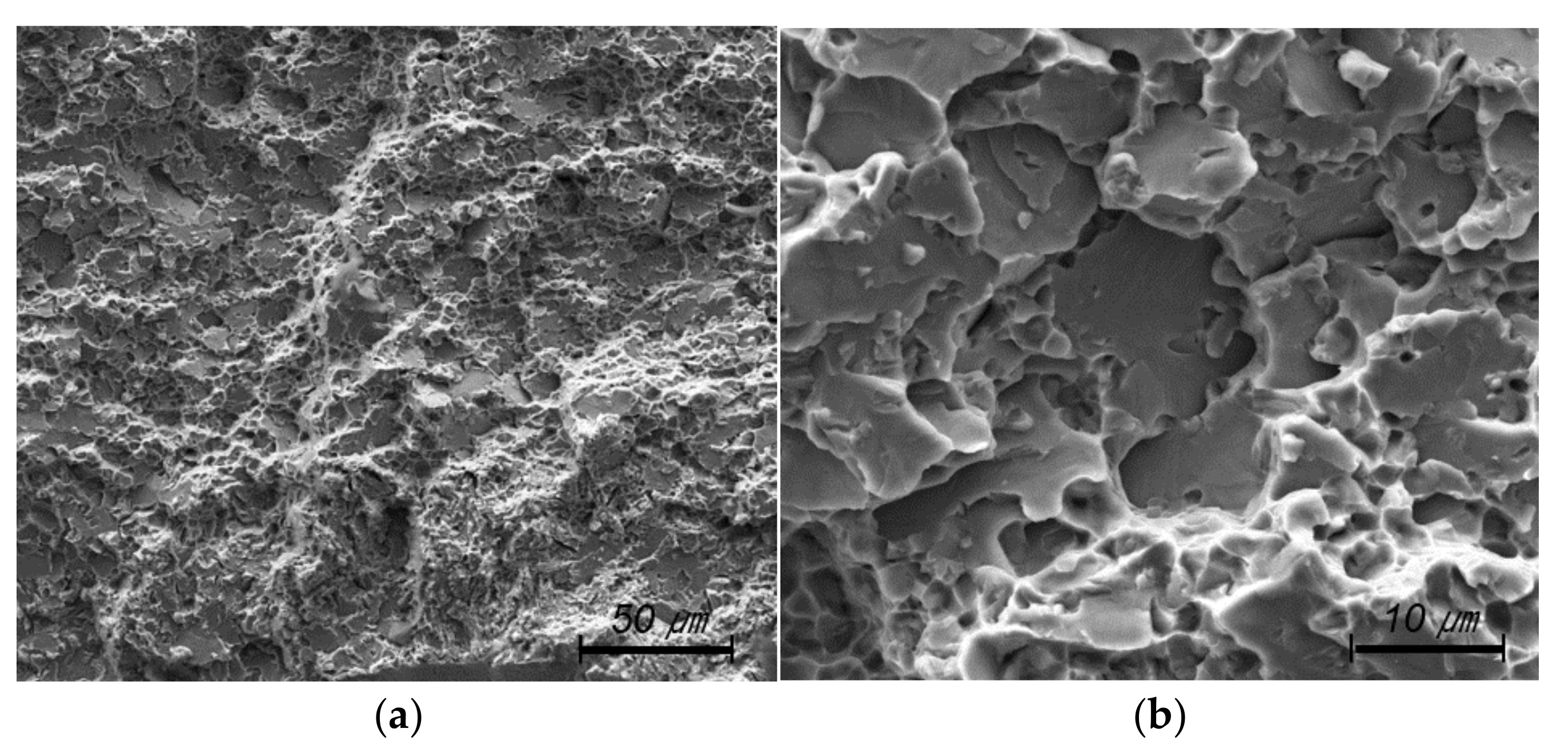
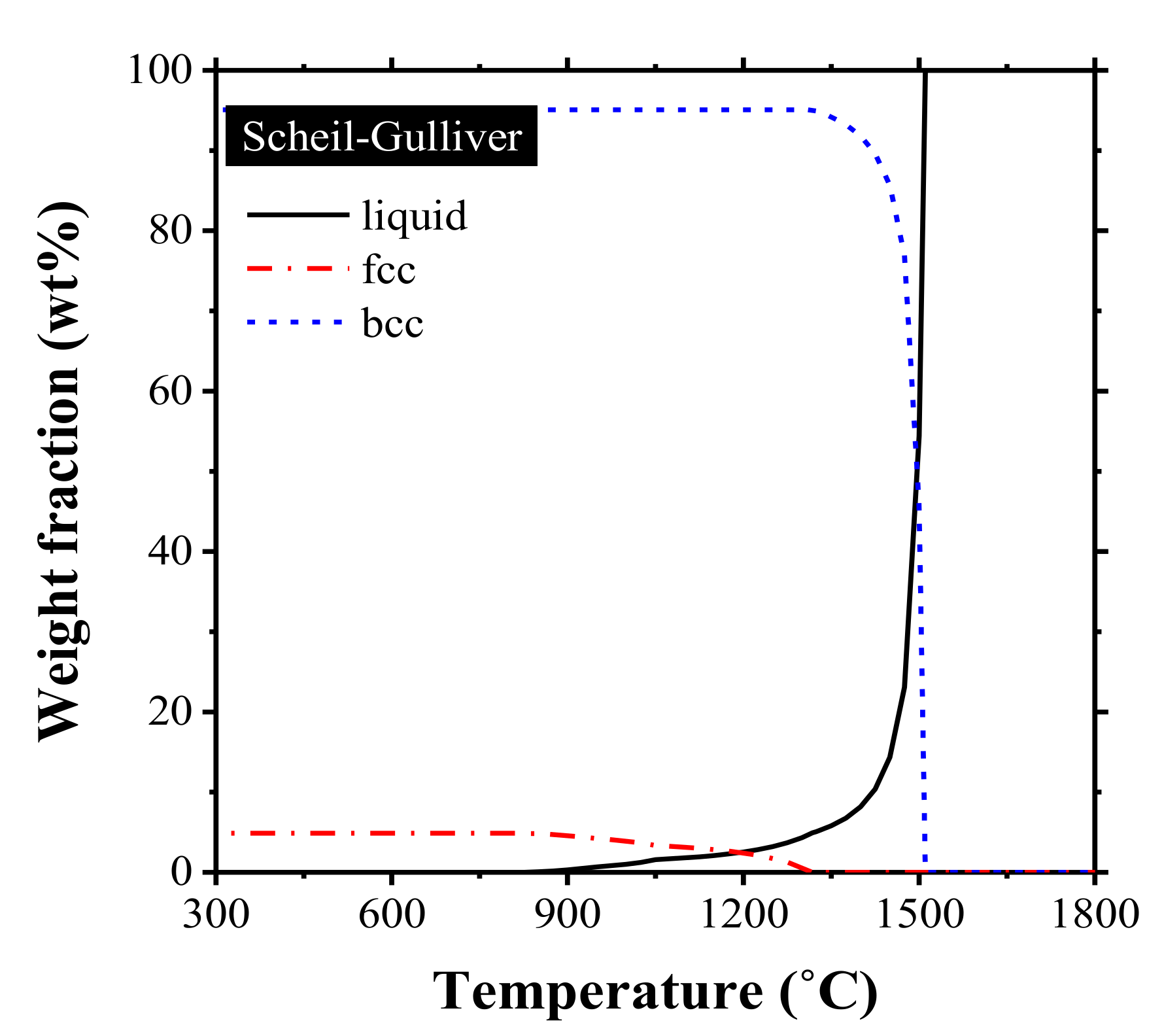
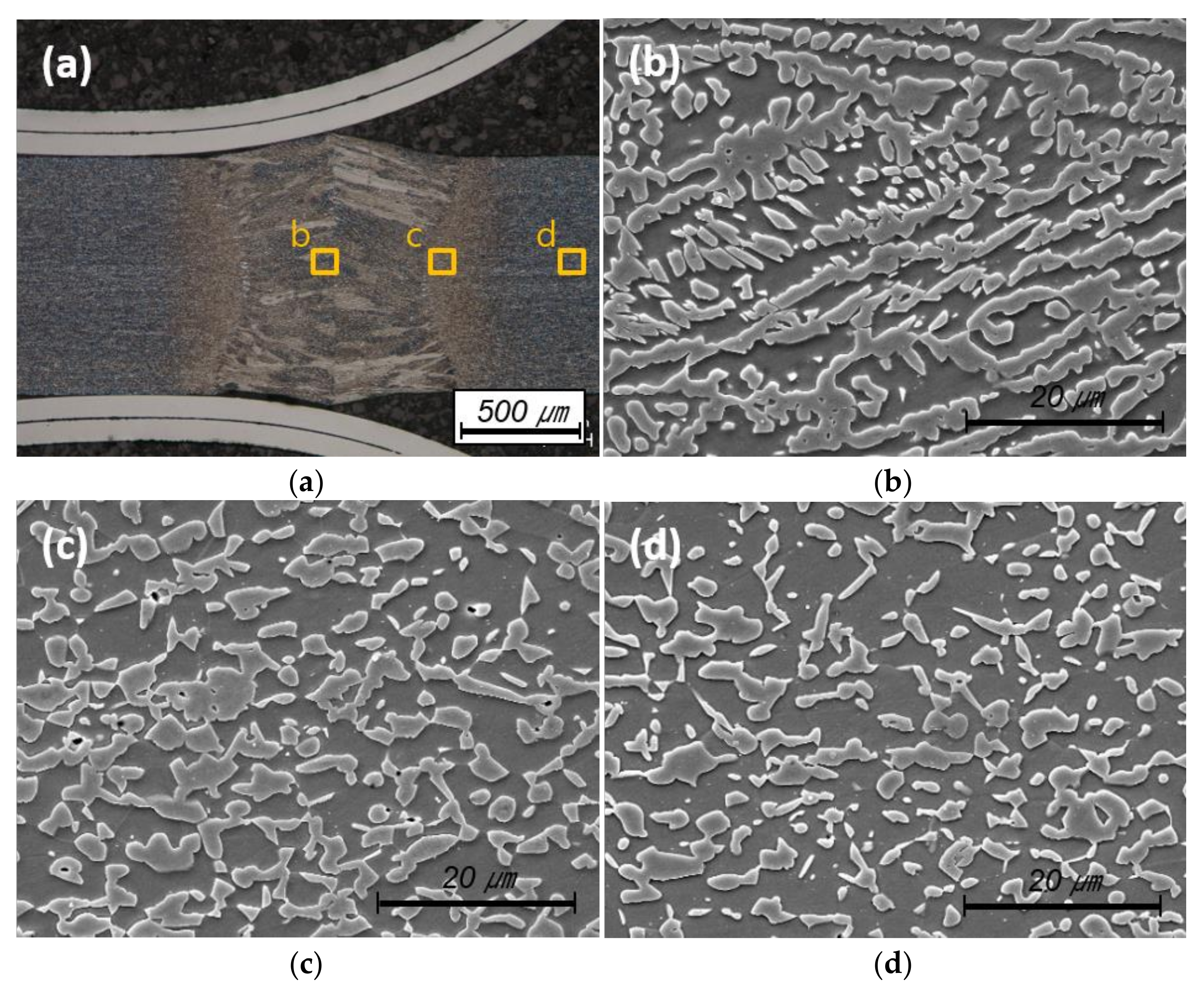
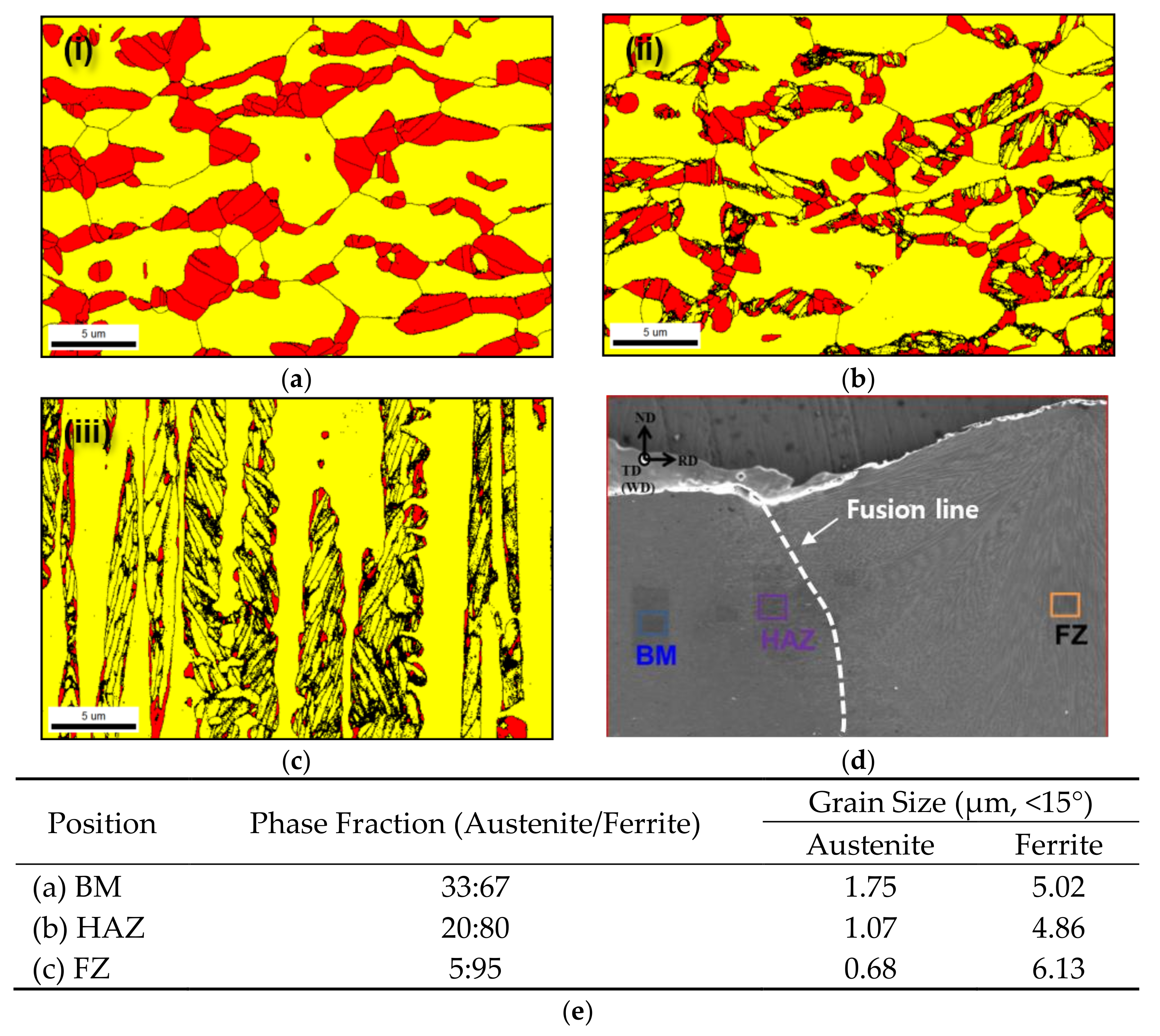
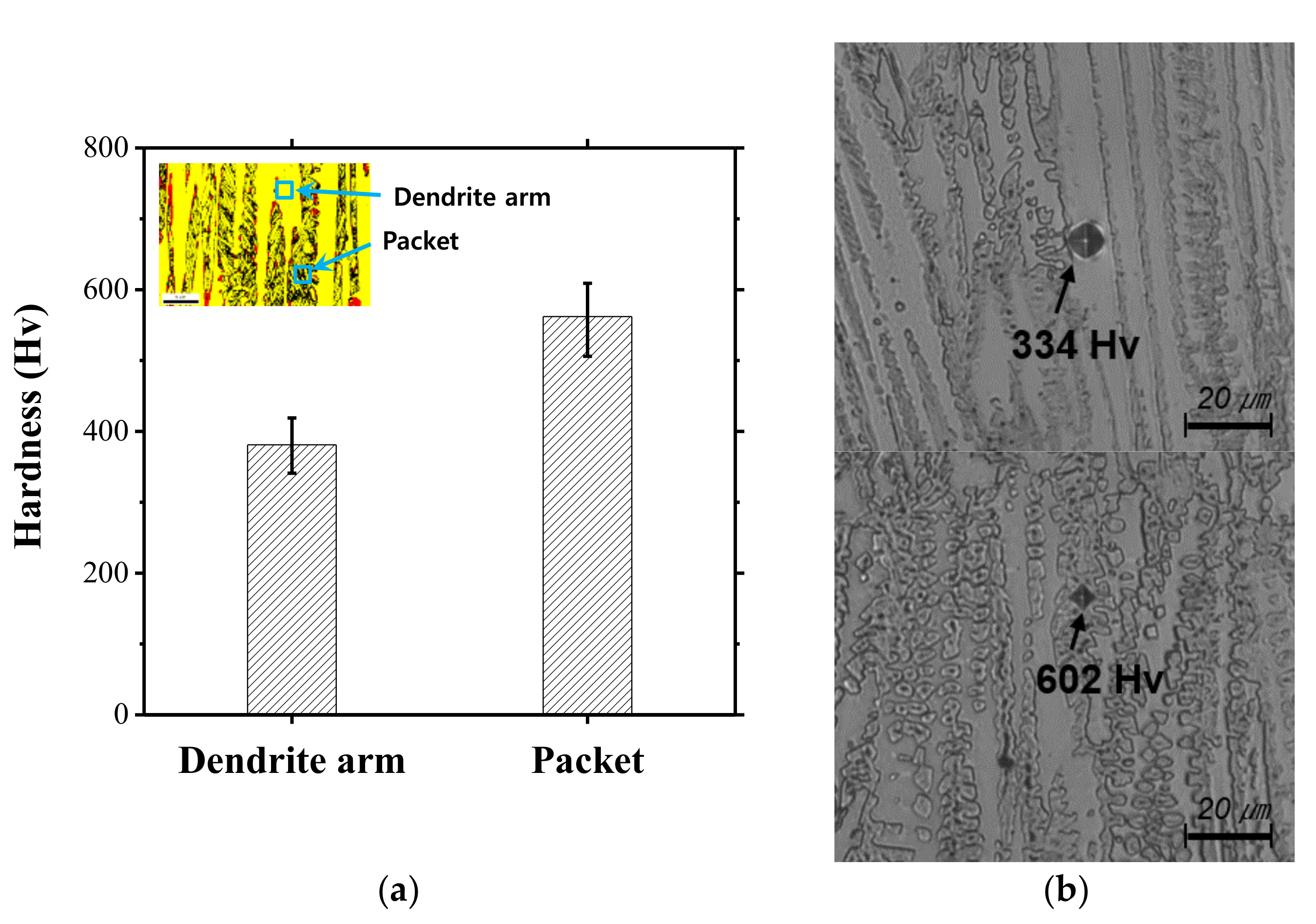


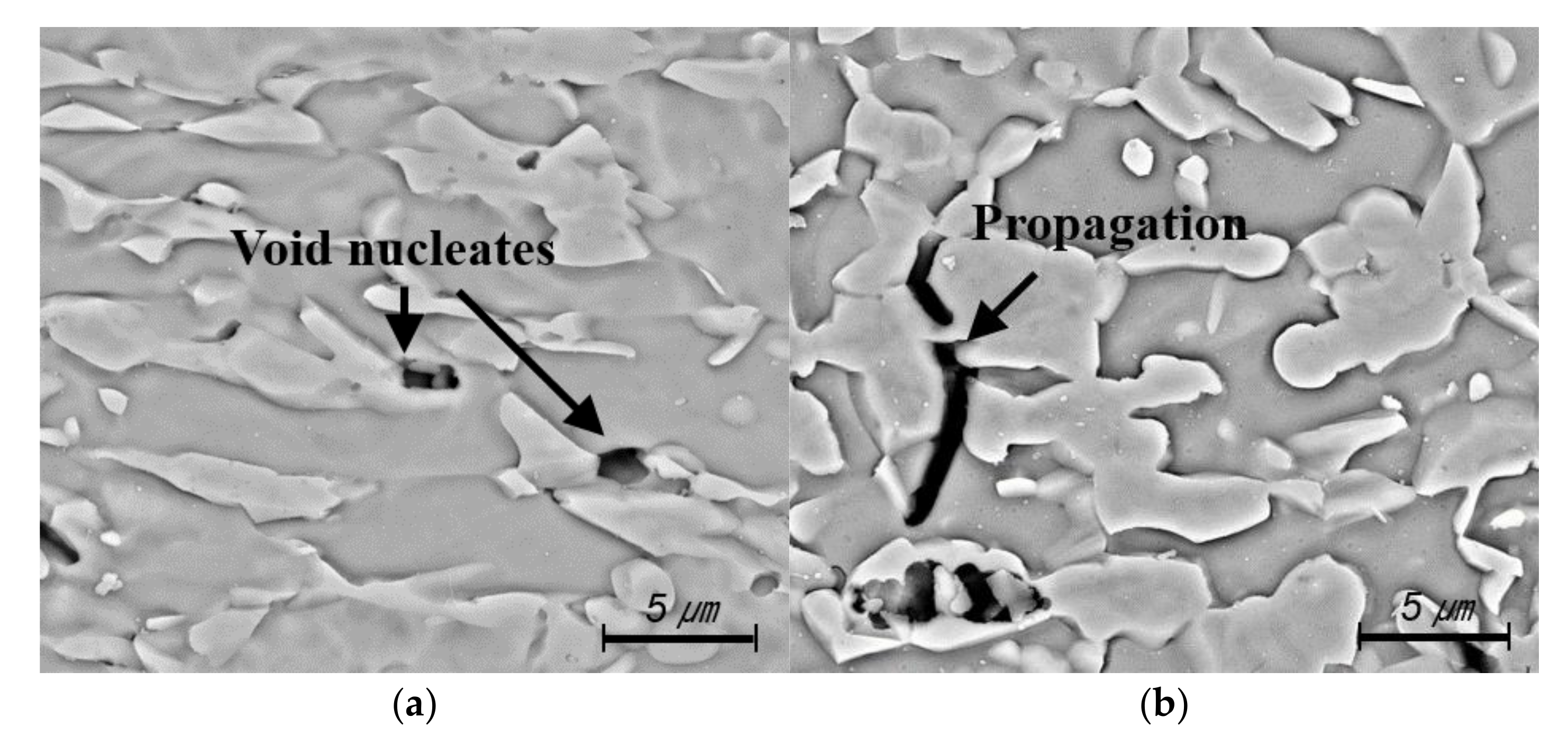
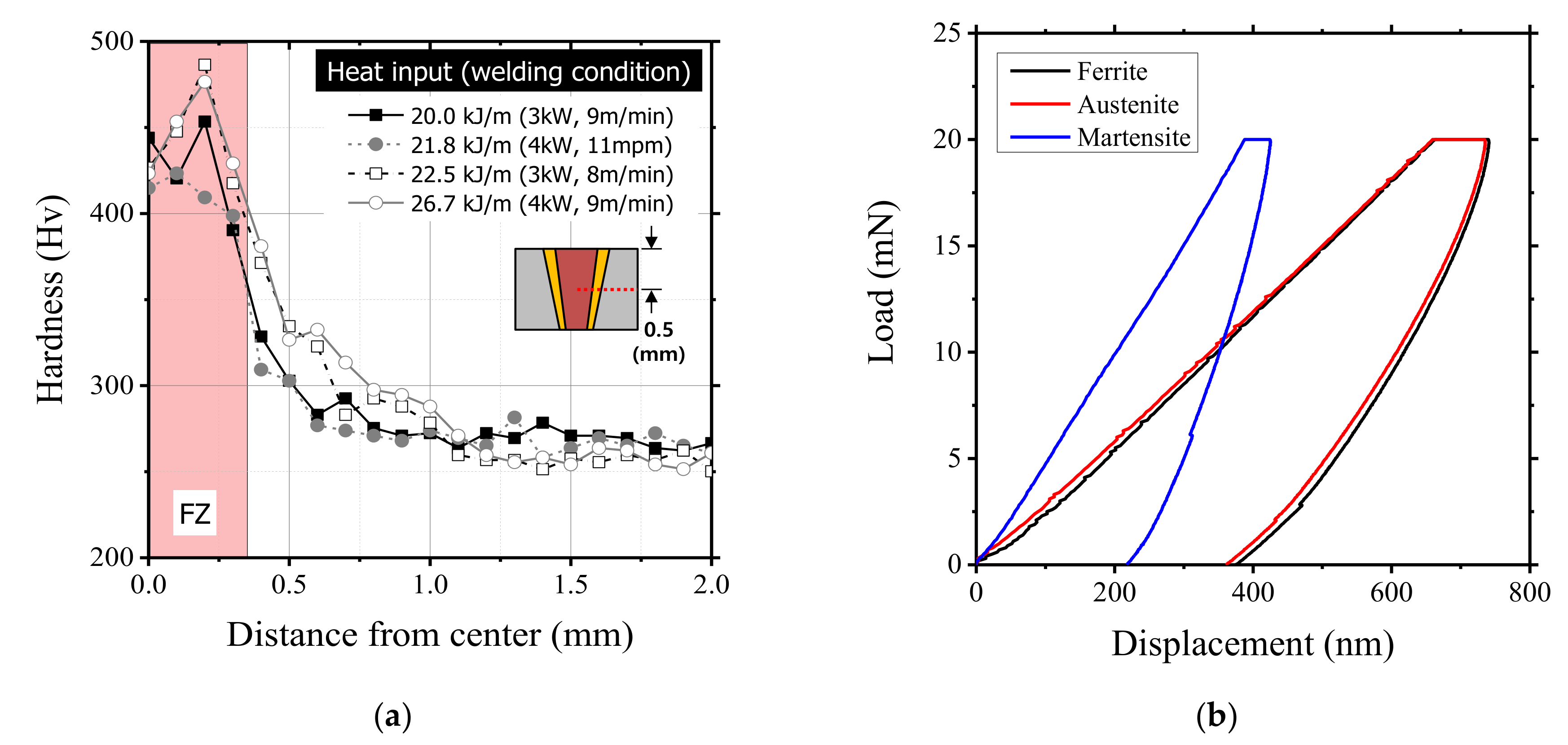
| Chemical Composition (wt %) | Mechanical Properties | ||||||
|---|---|---|---|---|---|---|---|
| C | Mn | Al | Si | Fe | Yield Strength (MPa) | Tensile Strength (MPa) | Elongation (%) |
| 0.3 | 3.7 | 5.2 | 0.11 | Bal. | 506 | 824 | 43 |
| No. | Laser Power, P (kW) | Welding Speed, WS (m/min) | Heat Input, H (kJ/m) |
|---|---|---|---|
| 1 | 3 | 8 | 22.5 |
| 2 | 9 | 20.0 | |
| 3 | 10 | 18.0 | |
| 4 | 4 | 9 | 26.7 |
| 5 | 10 | 24.0 | |
| 6 | 11 | 21.8 |
© 2017 by the authors. Licensee MDPI, Basel, Switzerland. This article is an open access article distributed under the terms and conditions of the Creative Commons Attribution (CC BY) license (http://creativecommons.org/licenses/by/4.0/).
Share and Cite
Kang, M.; Kim, Y.-M.; Han, H.N.; Kim, C. Effects of Phase Evolution on Mechanical Properties of Laser-Welded Ferritic Fe-Al-Mn-C Steel. Metals 2017, 7, 523. https://doi.org/10.3390/met7120523
Kang M, Kim Y-M, Han HN, Kim C. Effects of Phase Evolution on Mechanical Properties of Laser-Welded Ferritic Fe-Al-Mn-C Steel. Metals. 2017; 7(12):523. https://doi.org/10.3390/met7120523
Chicago/Turabian StyleKang, Minjung, Young-Min Kim, Heung Nam Han, and Cheolhee Kim. 2017. "Effects of Phase Evolution on Mechanical Properties of Laser-Welded Ferritic Fe-Al-Mn-C Steel" Metals 7, no. 12: 523. https://doi.org/10.3390/met7120523





